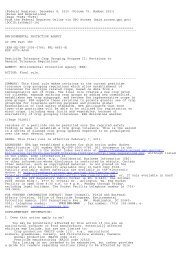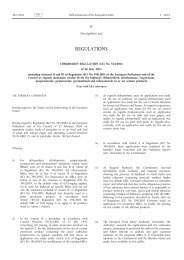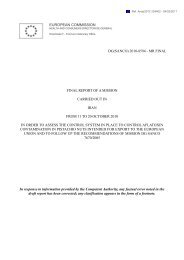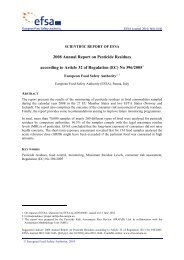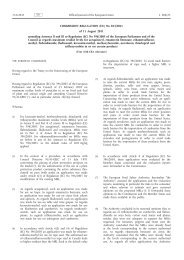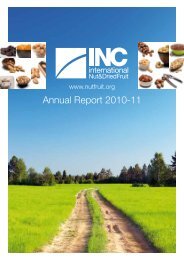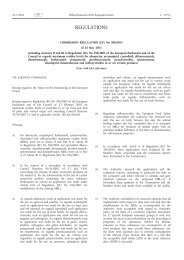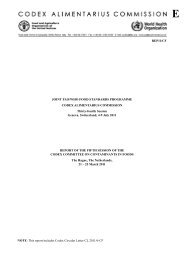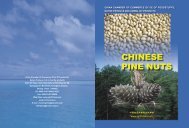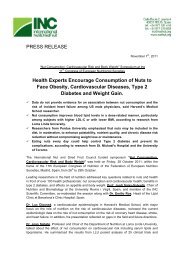final report of a mission carried out in brazil from 15 to 24 march ...
final report of a mission carried out in brazil from 15 to 24 march ...
final report of a mission carried out in brazil from 15 to 24 march ...
You also want an ePaper? Increase the reach of your titles
YUMPU automatically turns print PDFs into web optimized ePapers that Google loves.
• DIPOV has <strong>15</strong> federal <strong>in</strong>spec<strong>to</strong>rs for food <strong>of</strong> plant orig<strong>in</strong> <strong>in</strong>volved <strong>in</strong> the supervision <strong>of</strong> theBrazil nut production cha<strong>in</strong>. These <strong>in</strong>spec<strong>to</strong>rs are located <strong>in</strong> 6 SFAs — <strong>in</strong> the ma<strong>in</strong> Brazil nutproduction states — 3 <strong>in</strong> Acre, Amazonas, Pará and Ma<strong>to</strong> Grosso, 1 <strong>in</strong> Rondônia, Amapáand Roraima.• The CGAL is responsible for authoris<strong>in</strong>g and audit<strong>in</strong>g labora<strong>to</strong>ries as required by M<strong>in</strong>isterialNormative Instruction No 1 <strong>of</strong> 16 January 2007.• Accord<strong>in</strong>g <strong>to</strong> MAPA, VIGIAGRO is responsible for import and export controls on animalsand foodstuffs, <strong>in</strong>clud<strong>in</strong>g the control <strong>of</strong> Brazil nut consignments at the po<strong>in</strong>t <strong>of</strong> export prior<strong>to</strong> export. There are 106 control po<strong>in</strong>ts (border po<strong>in</strong>ts, <strong>in</strong>land cus<strong>to</strong>ms posts, ports and<strong>in</strong>ternational airports) where VIGIAGRO is represented <strong>in</strong> Brazil. There are 4 po<strong>in</strong>ts <strong>of</strong>export <strong>in</strong> Pará State — the Belém, Santarém and Vila do Conde ports and Val de CansInternational Airport, with a <strong>to</strong>tal VIGIAGRO staff <strong>of</strong> 32 persons. The <strong>mission</strong> team was<strong>in</strong>formed by the VIGIAGRO <strong>of</strong>fice <strong>in</strong> Belém that VIGIAGRO controls on Brazil nuts at thepo<strong>in</strong>t <strong>of</strong> export <strong>in</strong>clude checks <strong>to</strong> ensure that the Health Certificate is present and that theexporter is authorised <strong>to</strong> export Brazil nuts. However, the <strong>mission</strong> team noted that neitherMAPA Normative Instruction No 12/2004 nor MAPA Normative Instruction No 13/2004mention VIGIAGRO or conta<strong>in</strong> clear procedures for VIGIAGRO controls. In addition, the<strong>mission</strong> team was <strong>in</strong>formed by MAPA that VIGIAGRO would only control products subject<strong>to</strong> phy<strong>to</strong>sanitary certification; however, there is no such phy<strong>to</strong>sanitary certificationrequirement for the export <strong>of</strong> Brazil nuts <strong>to</strong> the EU. The <strong>mission</strong> team was <strong>in</strong>formed by theCA at the clos<strong>in</strong>g meet<strong>in</strong>g that the recently adopted MAPA Normative Instruction No11/2010 clarified VIGIAGRO’s role <strong>in</strong> the whole control procedure. In addition,VIGIAGRO representatives <strong>to</strong>ld the team that all 106 po<strong>in</strong>ts <strong>of</strong> export had already beennotified <strong>of</strong> the requirements <strong>of</strong> MAPA Normative Instruction No 11/2010.The MAPA ha sstate <strong>of</strong>fices, the SFAs, where the Plant and Animal Products Inspection Service(SIPAG) units are located, whicha are responsible for:• the <strong>in</strong>spection <strong>of</strong> Brazil nut exporters for registration purposes (MAPA NormativeInstruction No 66/2003);• the sampl<strong>in</strong>g <strong>of</strong> nuts <strong>to</strong> be exported for afla<strong>to</strong>x<strong>in</strong> controls;• the <strong>in</strong>spection <strong>of</strong> exporters for RASFF follow-up purposes;• the control <strong>of</strong> GMP and hygiene requirements <strong>in</strong> Brazil nut exporters once MAPANormative Instruction No 11/2010 is <strong>in</strong> force.Tra<strong>in</strong><strong>in</strong>g <strong>of</strong> the staff responsible for the <strong>of</strong>ficial control <strong>of</strong> Brazil nuts has generally been organised<strong>in</strong> the course <strong>of</strong> research projects such as Conforcast project “Analytical Tools for Tra<strong>in</strong><strong>in</strong>g <strong>in</strong> Brazil<strong>to</strong> Ensure Brazil Nut Conformity Regard<strong>in</strong>g the Danger <strong>of</strong> Afla<strong>to</strong>x<strong>in</strong>” and ASBRAER (BrazilianAssociation <strong>of</strong> State Technical Assistance and Rural Extension Entities) project “Good Practices <strong>in</strong>the management <strong>of</strong> Brazil Nut”. With<strong>in</strong> this project good practices were promoted by ASBRAER <strong>in</strong>partnership with the MAPA and Brazilian Agricultural Research Corporation (EMPRAPA).The Conforcast project was implemented between 2006 and 2009 with a view <strong>to</strong> establish<strong>in</strong>ganalytical <strong>to</strong>ols for Brazil nut control such as analytical methods, sampl<strong>in</strong>g criteria, and referencematerial for <strong>of</strong>ficial labora<strong>to</strong>ries, but also <strong>in</strong>cluded tra<strong>in</strong><strong>in</strong>g for <strong>of</strong>ficial staff <strong>in</strong> the control <strong>of</strong>afla<strong>to</strong>x<strong>in</strong> contam<strong>in</strong>ation <strong>in</strong> Brazil nuts. A <strong>to</strong>tal <strong>of</strong> 3 tra<strong>in</strong><strong>in</strong>g sessions were provided for MAPAtechnical staff and representatives <strong>from</strong> the <strong>of</strong>ficial labora<strong>to</strong>ries. The tra<strong>in</strong><strong>in</strong>g also covered afla<strong>to</strong>x<strong>in</strong>sampl<strong>in</strong>g.In 2008, some 50 local agricultural eng<strong>in</strong>eers and agronomists <strong>in</strong> different regions were tra<strong>in</strong>ed aspart <strong>of</strong> the ASBRAER project. The project was coord<strong>in</strong>ated by the ASBRAER and tra<strong>in</strong><strong>in</strong>g was6



